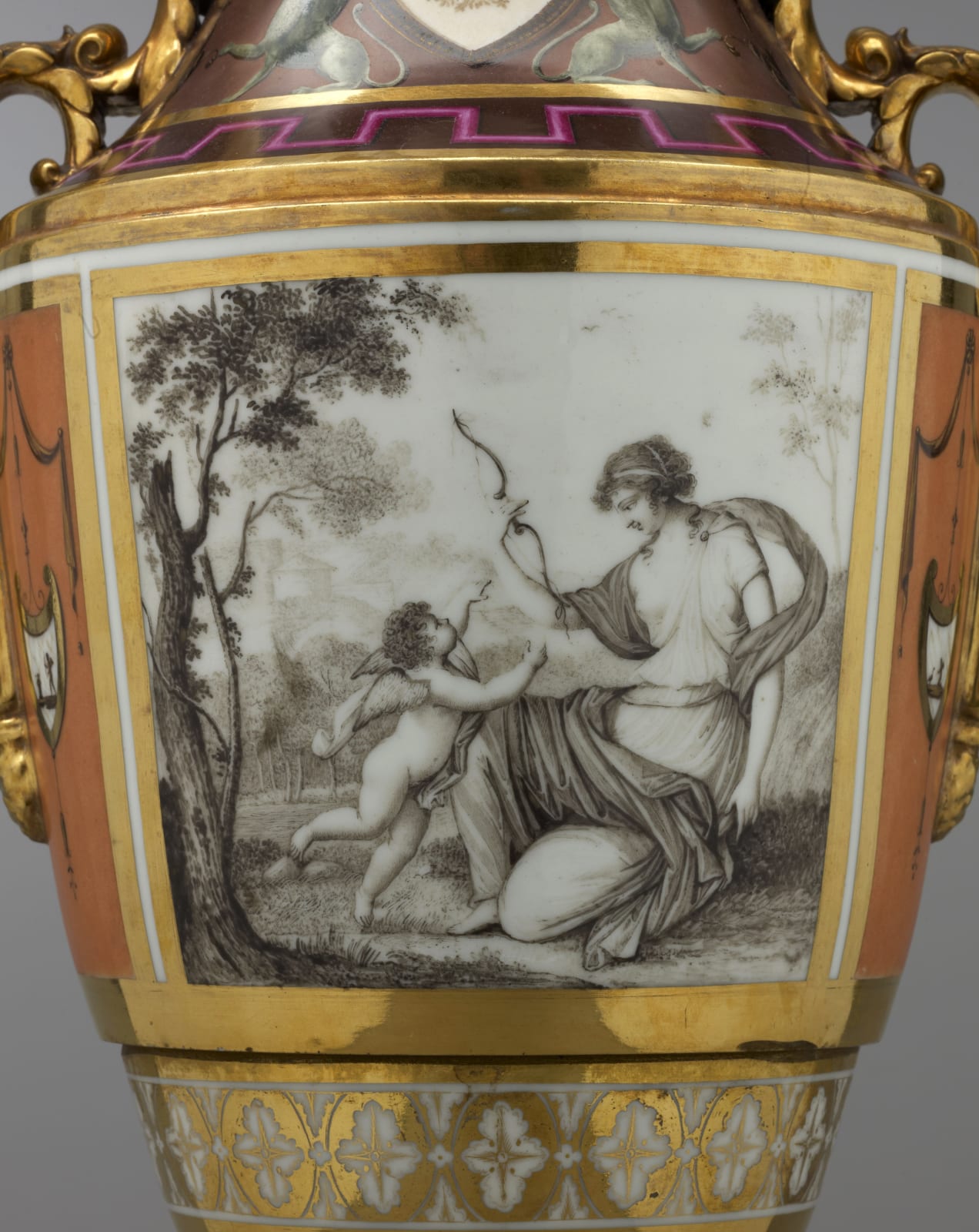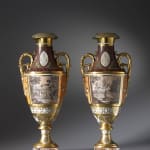Paris porcelain
A fine pair of Empire gilt bronze mounted gilt and polychrome painted Paris Porcelain two-handled vases bearing the decorator's indistinct signature L[?]evalleur, each of an elongated baluster form with a gilded rim above grisaille medallions between a pair of seated winged griffins flanked by scrolled foliate handles, the bodies painted en grisaille on the front and on the reverse within a gilt-edged rectangular panel showing scenes of Cupid and a classical maiden in an Arcadian landscape, one with Cupid hovering in the air and a maiden beside a flaming torch symbolising the fire of love, the other with Cupid dancing with a maiden evoking the joy of love, the scenes above a white and gilt patera border above further pairs of griffins flanking a lyre, on a shaped and spreading circular foot upon a square marble base
Paris, date circa 1825
Height 66 cm. each.
Whilst this pair of vases bare close comparison with examples made by the Sèvres Porcelain Factory, the lack of the Sèvres mark makes it impossible to ascribe them to the latter. Rather they should be described under the collective term of 'Paris Porcelain' that included some 37 factories appearing in and around the capital during the late 18th and early 19th centuries. Due to the number of different factories and often lack of markings it is generally impossible to distinguish the names of the different makers. However as we see here Paris Porcelain is distinguished by its quality; at its best it could rival the quality of Sèvres and has enjoyed an increased interest among collectors and critics alike during the past decade or so. The Sèvres Porcelain Factory became the property of the King in 1759. To protect its monopoly a number of laws were passed to restrict production of porcelain by other manufacturers. However the discovery in 1769 of kaolin, an essential component of hard paste porcelain, meant that after about 1770 new Paris factories began producing their own hard paste porcelain wares, many of which were copied or adapted from existing Sèvres designs. The administrators at Sèvres frequently complained that the new firms were not only imitating their colours and models but were luring their workers away with higher wages.
Until the Revolution the Sèvres factory was patronized by the King; likewise many of the newly emerging Paris factories were protected by members of the royal family or by other notable figures. These included a factory founded in 1771 by P-A Hannong at Faubourg Saint-Denis, which from 1779 was protected by the comte d'Artois; that at rue Thiroux founded c. 1775 under the protection of Marie-Antoinette, as well as a factory at rue de Bindy, founded 1780 under the patronage of the duc d'Angoulême. Others factories included one in the Petite rue Saint-Gilles, founded 1785 under the protection of the duchesse d'Angoulême and another in rue Amelot founded 1784 under the protection of the duc d'Orléans from 1786. Those that flourished during and after the Empire included one founded by N. H. Nast (at rue Popincourt) another by the Darte Frères (at various addresses) as well as ones founded by Honoré and Dagoty (Petite rue Saint-Gilles) and by P. Neppel. Many of the latter were awarded important commissions, for example Pierre Louis Dagoty was appointed supplier of porcelain to the Empress Joséphine. Important exhibitions during the Restauration period and reign of Louis-Philippe also accelerated the Paris Porcelain manufacturers to fame. However increasing urban manufacturing costs resulted in many moving to the provinces so that by 1850 only 17 factories remained within the city limits. With rising costs the trend continued so that with the collapse of the Second Empire in 1870 the production of Paris Porcelain virtually came to an end.



